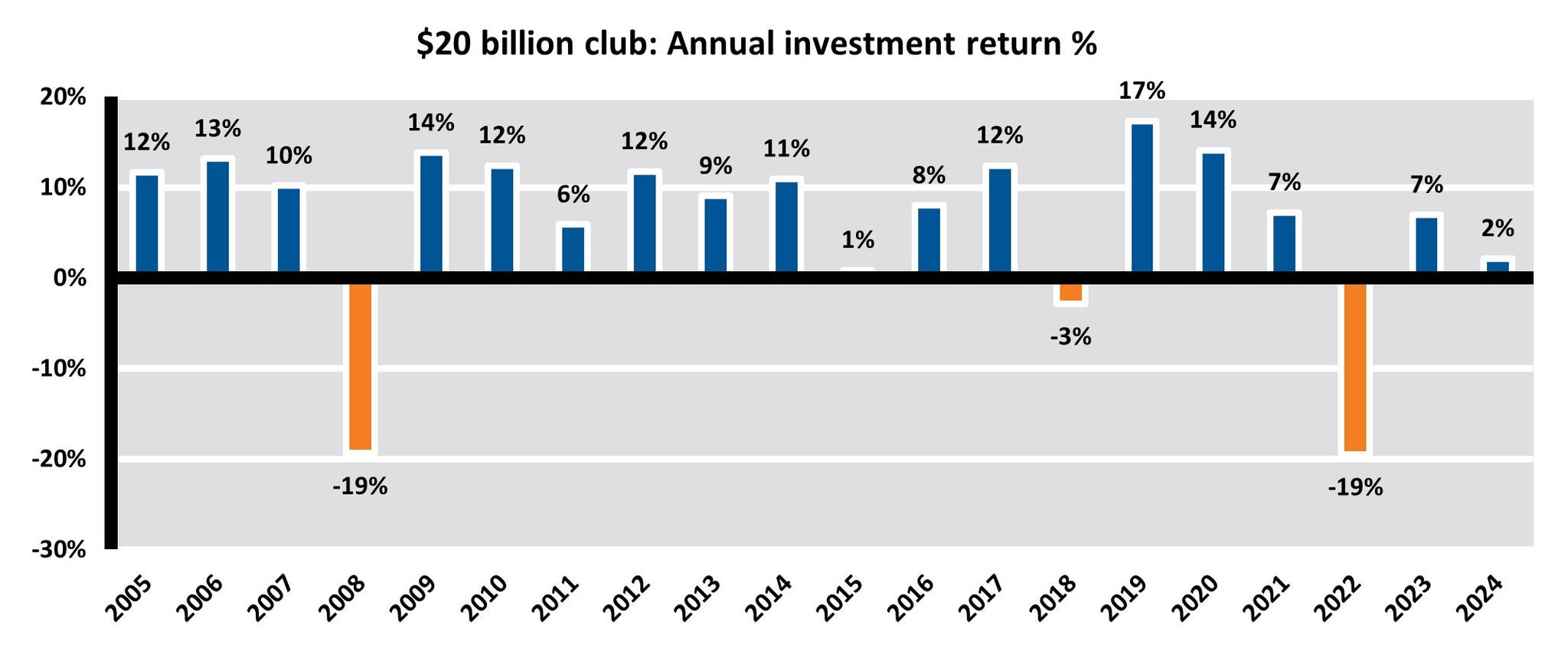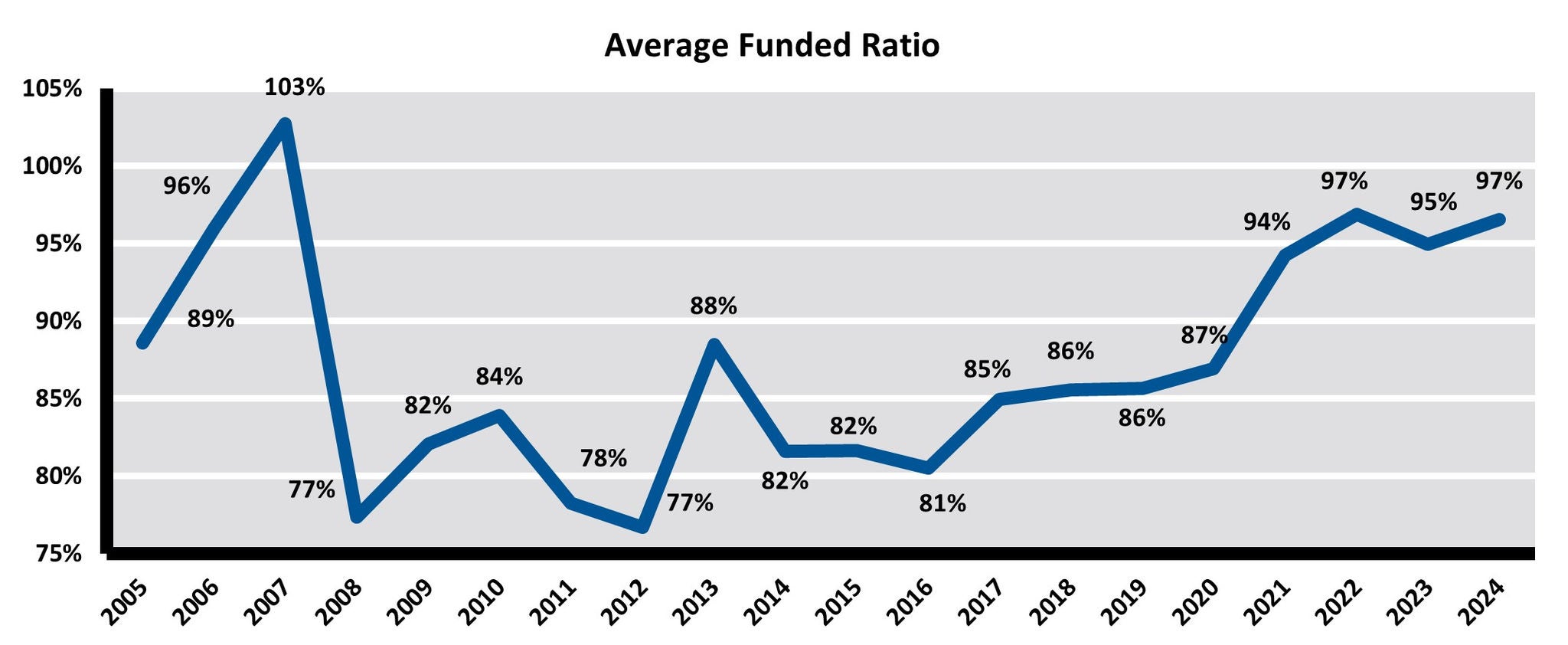Executive summary:
- Maintaining a healthy funded status, not maximizing investment returns, is the key objective for the largest U.S. pension plan sponsors. A healthy funded status puts these plans in a better position to satisfy benefit payments in the future.
- Members of the $20 billion club have increased their fixed income allocations significantly over the past 15 years—from about 37% in 2010 to near 60% today—as they progress on their de-risking glidepaths.
- We expect the trend toward liability-hedging fixed income to persist as funded status inches upward. We also expect ongoing interest in alternative asset classes.
- With discount rates staying relatively high since 2022, liabilities for the $20 billion club have plummeted to their lowest total in 20 years.
We just wrapped up our analysis of the U.S. public companies with the largest defined benefit (DB) liabilities—a group that we refer to as the $20 billion club. You can read the results here. Funded status was up a bit after a year with higher discount rates and good equity returns, but the investment returns for these large plans were not as large as you might have expected.
Even though these plans hold tens of billions of dollars each with access to a wide array of investment strategies and asset classes, investment returns were muted, at about 2% at the total portfolio level over the course of a year—in a year where the S&P 500 was up over 20%.
Exhibit 1 shows the trend of portfolios returns for this group over the last 20 years. Most years are up, as equity returns are usually positive and rates have been falling. In fact, in only three years have the returns been negative (2008, 2018, and 2022).
Exhibit 1

Source: 10-K filings, Russell Investments calculations
A lot has changed with these plans’ asset allocations over the last fifteen years. In summary:
- Fixed income allocations have increased from about 37% to nearly 60% as sponsors make progress on their de-risking glidepaths.
- Fixed income durations have increased as sponsors seek to hedge more interest rate risk with their LDI strategies.
- Sponsors are allocating higher amounts to alternative strategies to diversify growth assets and manage risk.
What is the goal of these portfolios?
Why have these sponsors made these changes, and how did it lead to lower returns in 2024?
Before we jump to conclusions on the inadequacies of their strategic asset allocations, let’s consider these plans’ objectives. Are they seeking a specific return target each year? Unlike other large asset pools, such as university endowments or state pension systems, U.S. corporate DB plans often do not have an explicit return objective, and a year of low returns is not necessarily considered a setback.
So what is their investment objective? Let me give a few examples from these companies’ annual filings:
- Boeing: “…to satisfy the benefit obligations of the pension plans…”
- FedEx: “…to earn a long-term investment return that meets our pension plan obligations.”
- Ford: “…minimize the volatility of the value of our U.S. pension assets relative to the U.S. pension obligations…”
In summary, these sponsors are trying to stay sufficiently funded to pay benefit payments in the future. And given the average funded ratio of these plans is much higher than it used to be (as shown in Exhibit 2), coupled with the fact that many of these plans no longer offer new benefits, they are able to scale back on higher-earning (and higher-risk asset classes) in pursuit of stabilizing their marked-to-market funded ratio.
Exhibit 2

Source: 10k filings, Russell Investments calculations
We expect that the trend toward liability-hedging fixed income to persist as funded status inches upward. We also expect continued interest in alternative asset classes.
Note in Exhibit 2 that funded ratio has actually been relatively stable the last few years, even during 2022 when almost every asset class saw negative returns and these portfolios experienced nearly 20% in investment losses. This supports the idea that these portfolios are doing what they were intended to do.
Note that while this exhibit shows that the plans are 97% funded, this includes all non-U.S. and even unfunded nonqualified pension liabilities, which must be included in the 10-K filings. In reality, many of these sponsors have fully funded qualified U.S. pension plans with minimal contribution requirements.
For the time being, discount rates used for both accounting and funding/contribution purposes in the U.S. are close to the same level, but this could change anytime. Liabilities used to calculate contribution requirements are based on a discount rate averaged over 25 years and are not able to be hedged with LDI (liability-driven investing), but sponsors may elect to change their discount rate method to be much closer to marked-to-market.
Persistently low assets and liabilities
Given that liabilities are highly sensitive to interest rate changes, it makes sense that when discount rates increase, the liabilities decrease. Rates have stayed relatively high since they rose in 2022, and total liabilities have stayed relatively low. It’s hard to believe that total liabilities were over $1 trillion just four years ago, while they currently sit at about $650 billion—their lowest total in 20 years.
Exhibit 3 shows how both assets and liabilities have evolved over the last 15 years, along with the discount rate changes.
Exhibit 3

Source: 10-K filings, Russell Investments calculations
The bottom line
With increasing allocations to fixed income, portfolio returns for the largest U.S. corporate pension plans will not necessarily match the headline market returns, but they are working toward meeting their objectives of satisfying future benefit payments. Through appropriate risk management, these sponsors can better secure benefits for future retirees.

